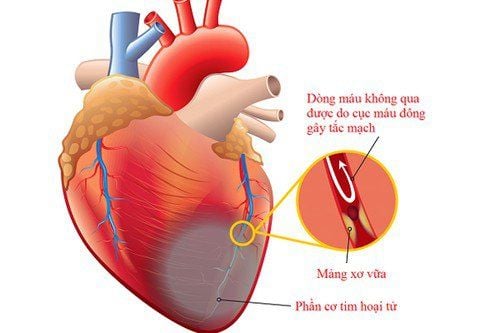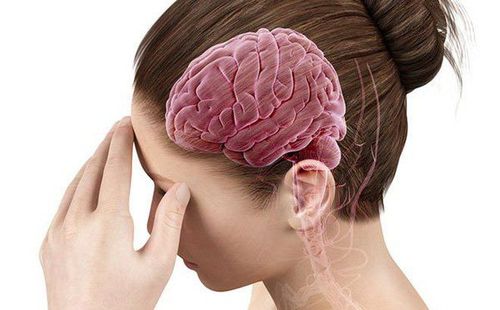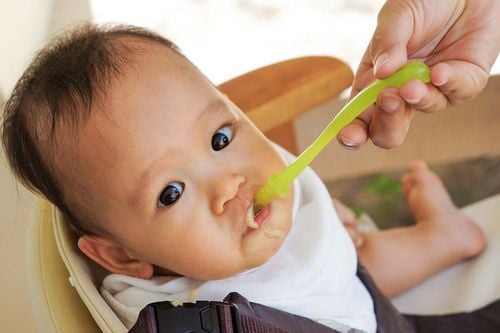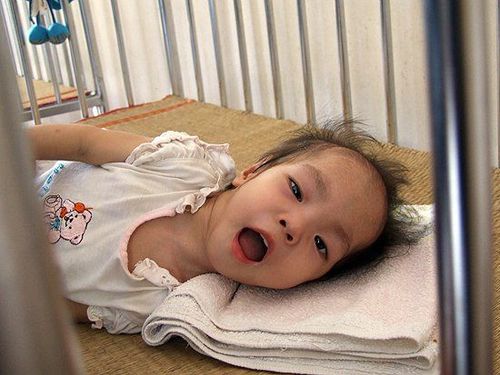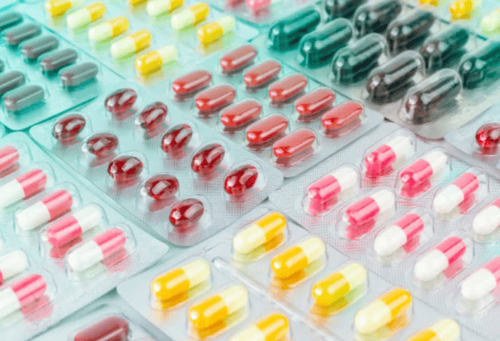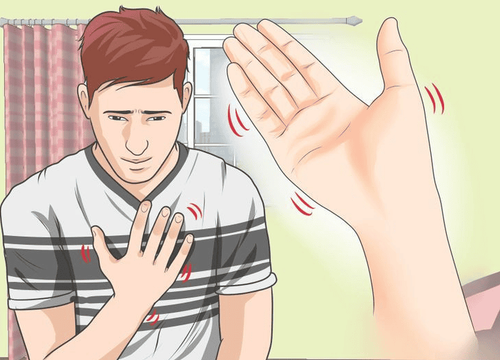This is an automatically translated article.
The article is written by Master, Doctor Vu Duy Chinh - High-tech Unit for Treatment of Cerebral Palsy and Autism - Vinmec Times City International HospitalThere are many proposed rehabilitation methods for treating cerebral palsy, but each method must have a full program, including: Rehabilitation of movement disorders such as spasticity, dancing. or dystonia, exercise self-control; treatment of hearing and vision disorders...
1. Principles of treating cerebral palsy with Rehabilitation
Rehabilitation is an important measure to help children improve lost or impaired functions, rehabilitation for children with cerebral palsy needs early and comprehensive participation with the patient's relatives for treatment. be continuous. Methods of rehabilitation for children with cerebral palsy include
Early rehabilitation through movement Rehabilitation through daily activities Rehabilitation through social communication Rehabilitation through special education appropriate to each level of intellectual development of the patient.
Training method
1. Exercise exercise
Correcting abnormal postures of the child's arms and legs. Exercise motor functions according to the child's developmental stages such as lifting head and neck, rolling over, sitting, crawling, kneeling, standing, walking... Stimulate and facilitate children to actively move through Game activities to train sensory perception: Touch, sight, hearing, taste. Techniques to adjust posture such as holding armpits, slings, lying in a hammock, swinging levers, sitting, balancing, standing...
2. Practice daily activities
Daily living skills including: Eating, cleaning, bathing, dressing... of children with cerebral palsy are often affected. Children with severe cerebral palsy often depend entirely on their family for help in all activities. With early, proper and persistent training, many children with cerebral palsy can be independent in their daily lives. This is very important, especially as the child with cerebral palsy is an adult.
2.1 Principles of daily living
The principle of daily living must be carried out as soon as possible, right after the detection and diagnosis of children with cerebral palsy. Training in daily living skills must be coordinated with other rehabilitation measures.
Feeding position
Mother sits on a chair, puts the baby on her back on her mother's lap, with the head in a neutral and slightly bent position. Bring the bottle / spoon of food from the bottom up to the baby's mouth. If the bottle/spoon from the top down into the mouth will make the baby stick his head back, the whole body becomes stiff, it is difficult to suck, chew, swallow. Techniques to control the mouth when feeding the child When food has been put into the child's mouth, we use our fingers to lift the child's lower jaw, helping the child close his mouth to hold the food and chew it better.
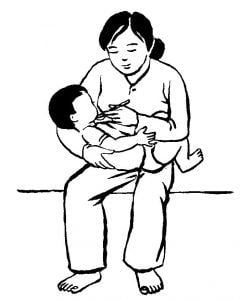
Practice feeding the child
Let the child bring the spoon from the top down to the mouth while the whole body is stretched, the other hand goes back, the whole body becomes stiff, it is difficult to suck, chew, swallow. The child sits in the front seat in an intermediate and slightly folded position. One hand is fixed on the child's shoulder, the other hand is supported at the wrist joint to help the child bring food from the bottom into the child's mouth. Children with cerebral palsy who cannot sit up on their own can learn to wear pants in a lying position. Good sitting posture helps children stabilize their posture when changing clothes. When the child is able to sit, or our hands fix the hips or thighs to help the child put on his socks. Practice toilet skills for children
Put the potty on the chair, the mother's hands hold the baby in a hip flexion position, bring the body forward, the legs separate. Set up a system to support children to hold hands when going to the toilet. Undressing skills Choosing a dressing position for the baby If the mother stands on one side, the baby turns to the other side, it will make it difficult for the mother to stretch the baby's elbow to undress the baby. Teach children skills to change clothes
Children lying on their stomach / sitting or holding a hoop on their legs and removed from their legs - motor skills children must do when changing clothes later. Children sit on a chair, with both hands holding the bracelets on their heads, gradually slipping down their legs - skills to put on clothes and pants later.
2.2 Practice through social communication
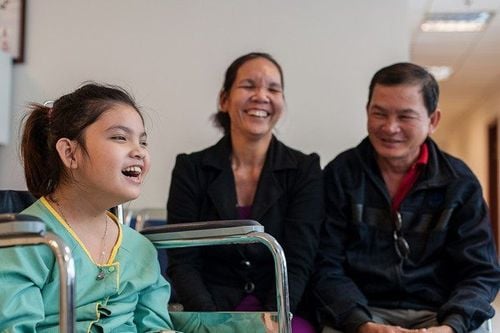
The brain as well as the body needs exercise, so it must be stimulated early through play. Language training for children as early as possible. Practice communication to help children integrate into society early.
Several ways to communicate
Signals with facial expressions, hands, head, body. Through pictures, drawing, writing, reading... Other forms of communication... Activities to stimulate skills
The activities below help children develop better relationship - communication skills , to help children learn awareness and act with purpose through caring for children with cerebral palsy at home: When holding or hugging a child, hold the child's hand to touch your face, maybe let the child touch the eyes, nose, ears, mouth... and introduce those parts to the child Give the child the ability to choose. Give your child cold water at first, then warm water. Give your baby sweets, then sour foods. For each activity, see how the child reacts, what he likes or dislikes, always responding to the child's (reasonable) things. When feeding your baby, stop halfway to see how the child will react, act out more. How does the child refuse to eat?
3. How to take care of children with cerebral palsy
How to hold a babyIf the baby usually lies with 2 arms bent, 2 legs stretched, hold them so that the arms are straight, the knees and groin flexed If the child has better control, it can be held in a low position Need help. Lying and sleeping
If the child lies with their legs crossed, a loincloth can be used to separate or fix the legs. If the child often leans back, it should be placed on his side, in a hammock or on a bucket. Tossing and turning
If the child has spasticity, relieve stiffness by pushing the child's legs back and forth; Then, help the child practice turning and rolling. Note: Find a game where the child wants to turn and turn himself. If the child cannot lift his head or lift his arms: Place the child in a two-handed position. Sit
If the child's legs are crossed and rotated inward, the shoulder joint is sagging, the hands are turned inward: Place the child to sit with the legs apart, raise the shoulders, rotate the limbs out. If the child has difficulty sitting: Hold the child's legs. Children with poor balance ability, their legs are often turned back (W-shaped) to prevent falling: Children should not be encouraged to sit in a W-shape because it may cause dislocation of the hip and knee. If the child is always spread his legs, the buttocks are raised back, the shoulder joints are brought back, first place the child so that the body is in a forward folded position, the legs are together, then bring the shoulders forward and rotate inward. . Then play with the child on the table; Sit facing the child so that the child has to reach out in front of the toy. Be sure to keep your feet flat. In addition, it is necessary to practice for children to stand, balance and move. Try to find ways for children to use both hands when playing and operating in different positions; Encourages touching, feeling and holding objects of different shapes, sizes, smoothness, hardness. Helper
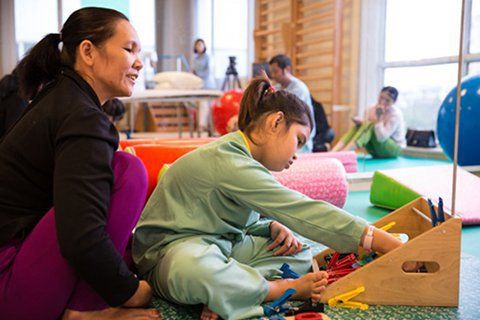
Early stimulation through play helps children develop intellectually: stimulates movement, balance, stimulates the senses, lets children play with toys with colors, sounds... Guide young families People with cerebral palsy know how to use and make some simple home aids for children such as: cloth pillows, seats, prone boards, walking frames, parallel bars, crutches, canes, neck support belts, protective hats Start... Making small adaptive items to help children more easily in activities such as spoons, chopsticks, toothbrushes, drinking glasses...
Please dial HOTLINE for more information or register for an appointment HERE. Download MyVinmec app to make appointments faster and to manage your bookings easily.





